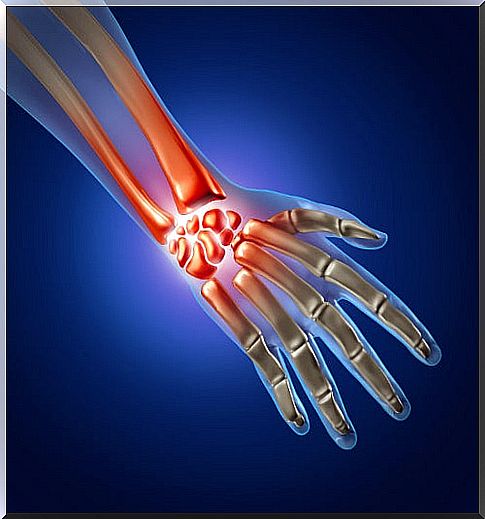Carpal Tunnel Syndrome: Causes And Symptoms
Carpal tunnel syndrome is a disease that causes damage to the median nerve. It usually presents with symptoms such as: pain in the wrist and forearm; cramps and tingling in the fingers, among other discomforts.
In mild cases, it can be solved by immobilizing the wrist, and in more severe cases, surgical treatment may be necessary.
When a patient suffers from this syndrome, it is difficult for him to carry out his activities normally, since the pain can become very sharp and unbearable.
Let’s see more about this below and what treatment measures are effective.
What is the carpal tunnel?

The carpal tunnel is a narrow canal that exists in the wrist. The so-called ‘median nerve’ passes through this tunnel, which is one of those responsible for the innervation of part of the hand.
As this channel is very narrow, there are several causes that can cause its diameter to reduce and ‘trap’ the nerve. In this way, it becomes very difficult for the nerve to work well.
Pressure on the median nerve causes sensitivity and movement of part of the hand to be severely affected. Therefore, we can suffer from a simple persistent and unstoppable tingling sensation, to a quite painful and nervous one.
At the same time we will notice weakness, especially in the combination of the thumb with the index finger. This happens because the muscles in the hand that reach the median nerve do not receive the necessary impulses to function well.
Over time, this situation can lead to permanent muscle damage. In addition, we can lose a lot of press force in the hands.
Causes of carpal tunnel syndrome
We have already mentioned that the area of the wrist where the nerve reaches the hand is called the ‘carpal tunnel’. This conduit is quite narrow. In this sense, any inflammation or thickening can compress or put pressure on the nerve.

It usually occurs, almost always, in people between 30 and 60 years of age, and is three times more common in men than in women. It does not usually happen, but there are cases in which those who develop this problem were already born with a small carpal tunnel.
It is a very common belief that doing the same hand and wrist movement over and over again causes carpal tunnel disease. This does not always have to be the case, although it is good to avoid certain mechanical and repetitive movements.
On the other hand, it is true that the use of vibrating hand tools can lead to this syndrome. For example, in the case of workers breaking concrete on roads with a jackhammer.
However, there are no good studies showing that carpal tunnel syndrome can be caused by manual labor. That is, for writing a long time on the computer, using the mouse or repeating movements while working. Nor for playing an instrument or practicing certain sports.
Other factors that may influence
Other factors that can lead to carpal tunnel syndrome:
- Amyloidosis
- Hypothyroidism
- Mellitus diabetes.
- Repeated fractures and arthritis of the wrist
- Growth on the wrist from a cyst or tumor.
- Fluid retention in pregnancy or menopause.
- Rheumatoid arthritis (autoimmune disease that affects the joints).
- Obesity and alcoholism. This last factor could be a relevant trigger, according to this study carried out by a team from the University of Medical Sciences of Havana, (Cuba).
Either way, most cases are idiopathic. That is, its real cause is unknown, so the treatment will be more oriented to the reduction of symptoms than to a cause itself.
Symptoms
- Pain in the hands or wrists.
- Weakness in one or both hands.
- Pain that goes from the wrist to the elbow.
- Persistent tingling in the palm of the hand.
- Problems with motor coordination of the fingers.
- Weak grip or difficulty carrying bags (a common complaint).
- Clumsiness of the hand when grasping objects with the fingers or the palm of the hand.
- Numbness or tingling in the thumb and next three fingers (index, middle, and ring).
In more severe cases, there may be atrophy of the muscle below the thumb.

Carpal tunnel syndrome or osteoarthritis?
It is important not to confuse the symptoms of carpal tunnel syndrome with those of arthritis (osteoarthritis). For this, it would be correct to consult with the doctor in case we experience discomfort such as:
- A constant pain that seems to increase even if we are with our hand extended for a long time in search of relief.
- Sensation that something creaks or crackles inside the wrists when moving them while doing an exercise.
Diagnosis
In order to carry out the diagnosis, the doctor will ask the patient:
- Striking the median nerve at the wrist can trigger pain from the wrist to the hand. (This is known as ‘Tinel’s sign’).
- Bend your wrist forward for 60 seconds to check for numbness, tingling, or weakness. (This is known as the ‘Phalen test’).
To complete, in addition to the physical evaluation, the doctor may recommend the patient to undergo some tests, such as:
- X-rays of the wrist: to determine the existence of a narrowing in the ligaments or tendons through which the median nerve passes. This is what causes the compression symptoms of the carpal tunnel.
- Electromyography: technique for the evaluation and recording of the electrical activity produced by skeletal muscles.
- Nerve conduction velocity.
These last two techniques will show abnormal results if the syndrome has been suspected before.
Treatments for carpal tunnel syndrome
We can immobilize the wrist with a wrist brace with a splint. This is a kind of rigid iron or additive that is put on at night, for a not too long period of time. It is usually only used for a few weeks.
If this does not help, it may be necessary to use it during the day as well and for at least a month. We must avoid sleeping on the wrists and, to relieve pain, cold compresses are recommended.
Medicines
Among the drugs used in the treatment of carpal tunnel syndrome are non-steroidal anti-inflammatory drugs. Some examples are ibuprofen or naproxen.
On the other hand, corticosteroid injections can provide symptom relief for a time. However, for severe cases we can resort to surgery.
Surgery
The so-called carpal tunnel release is a surgical procedure. In this process , the ligament that is putting pressure on the nerve is cut.
Surgery is effective in most cases, but not always, and complete healing can take months. Although symptoms usually improve with treatment, eventually more than 50% of cases require surgery.
How to prevent carpal tunnel syndrome?
There are many changes we must make in the workplace and at home to reduce the stress placed on the wrist. This is suggested by this article published in the Cuban Journal of Rheumatology.
Maintain a neutral position
- We are to observe ourselves when we are at rest. The hands must be extended, relaxed and without bending the wrists.
- We must avoid, whenever possible, the repetitive movements of these.
- The computer screen at eye level. The keyboard should be low enough so that the wrists do not bend up when typing.
- Finally, avoid grasping or unscrewing objects with three fingers, as this increases the pressure on the wrist. We must use the whole hand.
- If it is a continuous activity due to the work of each one, alternate them and give them a break of 1 to 2 minutes every so often.
We also highlight posture during night rest. When sleeping, the arms must be close to the body and the wrists straight. If the wrists get trapped under the body there will be pressure, pain and swelling, which could increase the pain related to carpal tunnel syndrome.

Use ergonomic designs
It is advisable that we use tools designed to reduce the risk of injury to the wrist. There are special devices for the computer that can be of great help.
Some examples are ergonomic mouse mats. Take a break from writing every so often and check for pain or tingling.
exercises with wrists and hands
They help improve circulation and, at the same time, reduce stress on the wrists and hands.
- Make circles with your wrists. To start, you should place your palms down and out. Then rotate both wrists to the left five times and then to the right.
- Tense the thumb. The hand should be held out and then the right thumb is grasped with the left hand. Press out and back, until you feel gentle tension. Keep it like that for ten seconds. Repeat on each thumb five times.
- Spread all five fingers. Extend your hand with your fingers well apart for 10 seconds. Repeat three to five times.
- Hold the hand. Firmly squeeze the hand with a rubber ball ten times. Then, you should stretch your fingers and repeat with the other hand.
As we have already mentioned, some of the jobs that involve vibrating tools are closely associated with this disease. It is frequent among professional musicians (pianists, flutists …).
Ice packs on the hand or wrist
The cold becomes a perfect ally to reduce inflammation. However, we will never apply hot compresses or heating pads, as it would make carpal tunnel syndrome worse.
To consider
In case the patient has any kind of doubt, it is best to consult with his doctor.
Once again, we remember the importance of avoiding self-medication, natural remedies, the application of hot compresses and other related issues, as they can be counterproductive.







